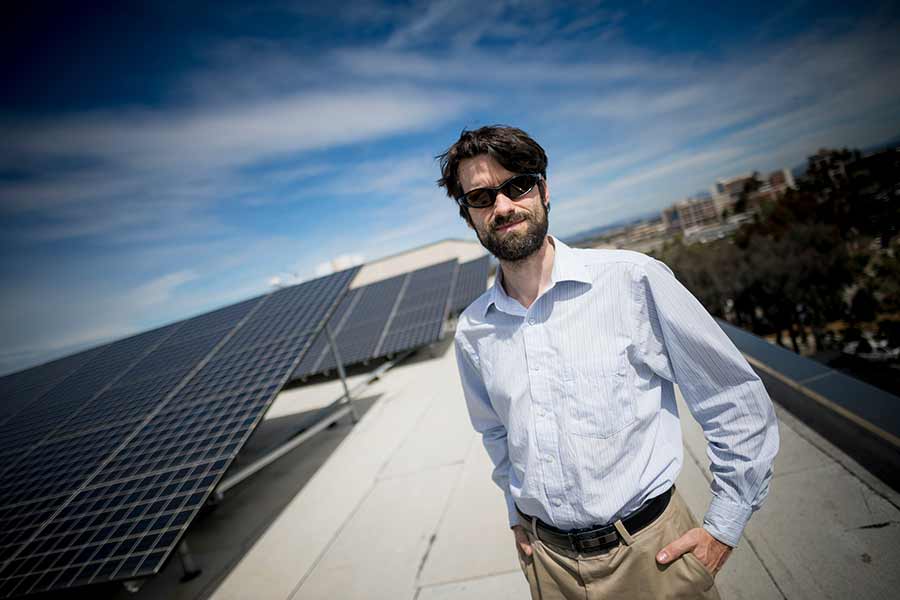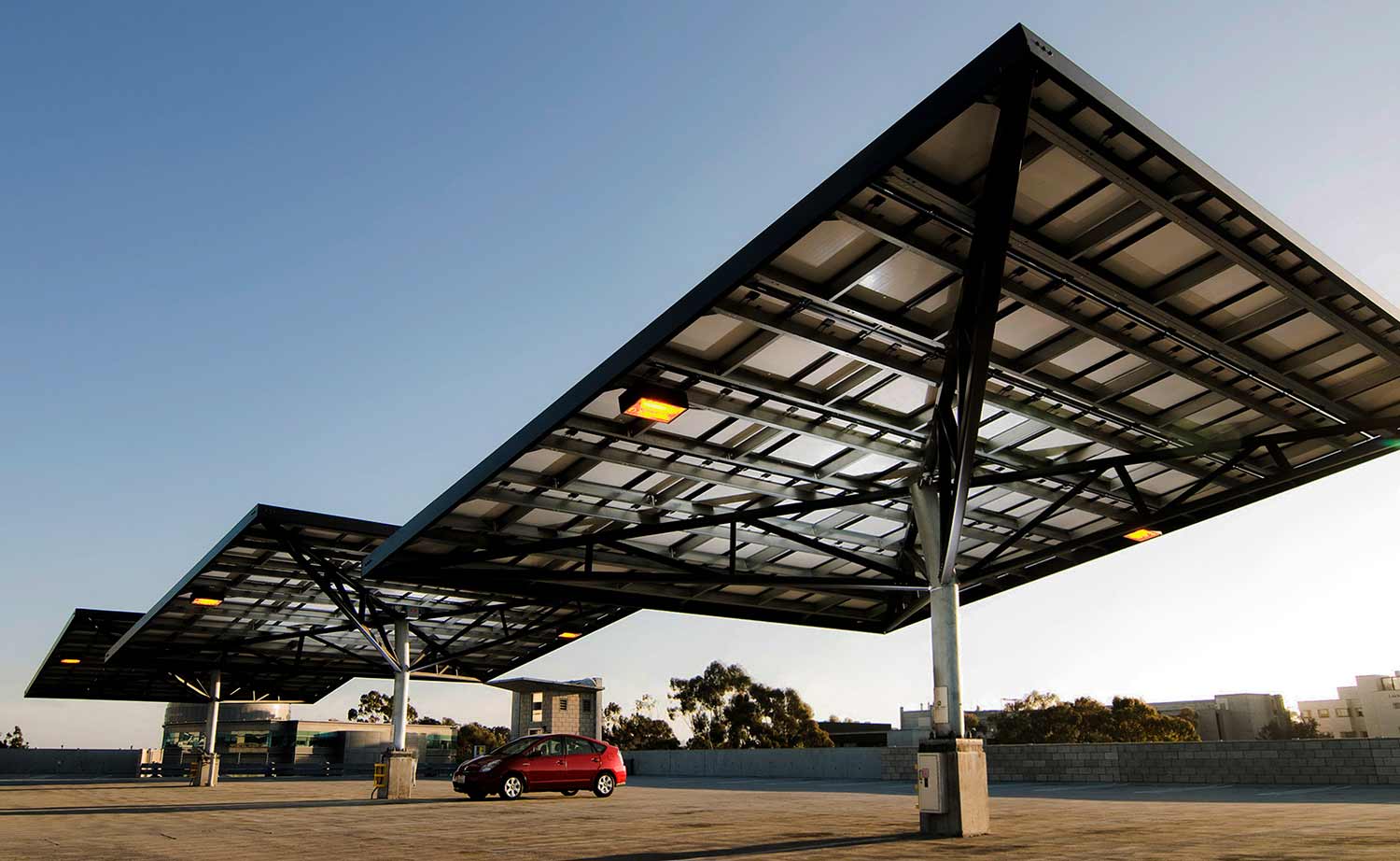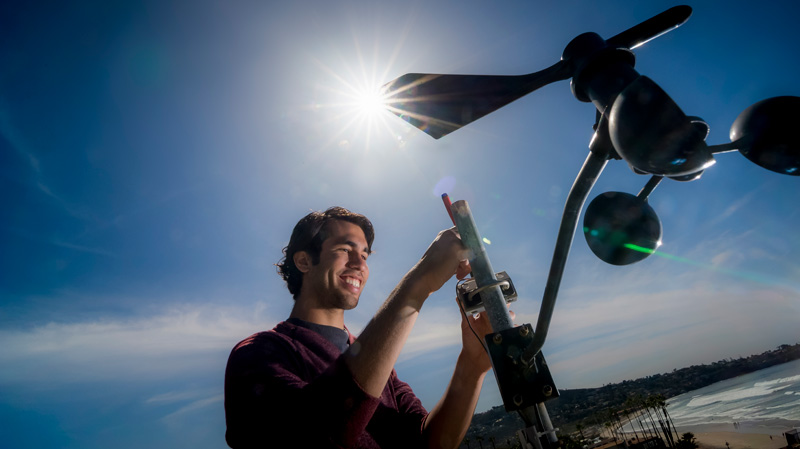By:
- Ioana Patringenaru
Published Date
By:
- Ioana Patringenaru
Share This:
$39 Million Grant to Better Integrate Renewables into Power Grid
The National Science Foundation has awarded $39 million to a team of engineers and computer scientists at the University of California San Diego to build a first-of-its-kind testbed to better understand how to integrate distributed energy sources such as solar panels, wind turbines, smart buildings and electric vehicle batteries into the power grid. The goal is to make the testbed available to outside research teams and industry by 2025.

Jan Kleissl is the principal investigator on the grant and director of DERConnect. He is a professor in the Department of Mechanical and Aerospace Engineering.
The major driver for the project is the need to decarbonize the electrical grid, protect it from cybersecurity attacks and make it more resilient. To provide 50 percent—or more—of power from clean energy sources, power grids will have to be able to leverage distributed energy sources, and reliably manage dynamic changes, while minimizing impact on customer quality of service.
“We will be replicating the entire California power grid on one campus,” said Jan Kleissl, a professor in the Department of Mechanical and Aerospace Engineering at UC San Diego and the project’s principal investigator.
The creation of the testbed, DERConnect, addresses an outstanding national need for large-scale testing capabilities across universities, national labs, industry, utility companies and Independent System Operators to validate future technologies for autonomous energy grids in real-word scenarios. In fact, a major current obstacle to the adoption of such technologies in the operations of real energy systems is the development of realistic test cases on a realistic scale.
Most utilities struggle with the fact that renewable and distributed energy sources are not as stable as traditional sources, such as natural-gas power plants. Solar panel output depends on the weather, for example, as do wind turbines. At the other end of the grid, electric vehicles need charging for only a certain amount of time every day, and when not in use could be used as temporary batteries to store energy from renewables.
As a result, while the number and diversity of distributed energy resources on the power grid is rapidly expanding, the adoption of these resources for power-grid balancing is hindered by concerns about safety, reliability and cost.
“This created the classic ‘chicken-and-egg’ situation, where the economics and impact of distributed energy resources cannot be demonstrated because there are too few of them due to limited buy-in from Independent System Operators, and other practical concerns,” Kleissl said.
Offering utilities, researchers, industry and other entities a testbed with real-world communications challenges is essential to solve these problems and develop new distributed control theories, algorithms, and applications. The envisioned testbed is built upon a number of technical innovations at UC San Diego that create a microgrid encompassing distributed energy resources, including energy storage, electrical vehicles and independent electrical and thermal systems in buildings. This distributed system is monitored and controlled by computing and networking systems that make it accessible to local and remote researchers as a programmable platform.

Solar trees on the top floor of the Gilman Parking structure at UC San Diego.
“The ultimate goal of any grid is reliability, and it is a top concern at UC San Diego, as we must constantly power medical centers and major research facilities,” said Gary Matthews, Vice Chancellor of Resource Management and Planning. “The ability to interact with buildings and change their energy profile intelligently both enhances grid stability and saves a tremendous amount of energy. We support this living laboratory at the highest level, as this grant allows us to put infrastructure in place for future research, collaborating with leading scientists on real world solutions.”
DERConnect will include more than 2,500 distributed energy resources, or DERs, on the campus’ microgrid, with its fuel cell and solar panels, a dozen classroom and office buildings, as well as 300 charging stations for electric vehicles. It will also entail the construction of a new energy storage testing facility on the East Campus.
An upgrade to the microgrid will give researchers real time control over heating, ventilation and air conditioning systems, lighting, solar panels, battery storage and EVs. The testbed’s control center will be housed in Robinson Hall on the UC San Diego campus, which will be turned into a fully controllable building that can be disconnected from the campus’ grid at any time.
The bulk of the construction will take place this coming academic year. Researchers hope to be able to begin testing their equipment in 2022.
DERConnect will be the first integrated platform in the United States that matches the needed experimental evaluation and validation for the implementation of DER technologies, protocols, and standards. A wide range of smart grid implementation use cases and testing procedures will be established to provide controlled laboratory evaluations of DER control algorithms, emerging technologies, and protocols in areas such as distributed and renewable energy integration, energy storage systems, advanced distribution management, advanced metering infrastructure, and cybersecurity. DERConnect will be able to explore which architectures and corresponding resource aggregation approaches allow consumers and grid operators to adapt their operations to achieve significant improvements in system-wide operational cost and renewables integration.

A graduate student checks a weather monitoring station at the Scripps Institution of Oceanography.
UC San Diego is building on experience from NODES, a three-year, $2.88 million grant from ARPA-E, led by Sonia Martinez, a professor in the Department of Mechanical and Aerospace Engineering, who is also the CO-PI on DERConnect. NODES’ aim was to develop transformational grid management and control technologies to facilitate the integration of renewables and DERs, increase operational efficiency and reduce carbon footprint. NODES involved the same research team and constitutes the intellectual backbone of DERConnect in the development and preliminary testing of algorithms for decentralized control of DERs. The testing carried out at the UC San Diego microgrid was among the most successful ones due to the number of devices, their diversity, and the alignment with real-world operating conditions. Building on this experience, DERConnect strives to be a plug-and-play experience for users with a much larger number of devices, minimal overhead for users in terms of platform readiness, and failsafe system that allows experiments at any time of the day.
Experiments and algorithms
DERConnect will provide advanced controls, sensors, and data analytics to optimize building energy use, while maintaining and even improving comfort for occupants. For example, the Computer Science and Engineering building is instrumented with over 4,500 sensing and control points. Every control unit can be controlled, from the position of air dampers to the speed of supply air fans to a room. DERConnect will upgrade 12 additional buildings with advanced control infrastructure that enables researchers to access operating conditions and set various operating parameters in real time through novel programming methods and tools. This capability is particularly important as indoor operating conditions in buildings with central air handling become an important focus for researchers and building operators to reduce the spread of infectious diseases.
Researchers plan to conduct experiments to optimize learning conditions for students by changing airflow, temperature, humidity and lighting conditions in classrooms. Similarly, researchers could make changes in the energy prices at EV charging stations and see how this impacts customer willingness to delay charging to benefit the power grid.
Outreach efforts and education
The testbed will also become a training ground for students in the new Systems Engineering program at the UC San Diego Jacobs School of Engineering as well as data-driven research and capstone projects tied to the Halicioglu Data Science Institute Data Science Institute at UC San Diego.
Outreach efforts for elementary through high schools will take the form of a Research Experience for Teachers program, targeting 10 teachers coming from schools with a high number of students who are under-represented in engineering. Classes will also be able to tour the testbed and related lesson plans will be provided to their teachers.
The team will also work with Santa Fe Community College in New Mexico to develop a course focused on local data and technologies to inform planning, operations and maintenance, and the decarbonization of microgrids.
In addition, the team will offer microgrid workshops for Native American tribes. The workshops will offer training sessions on key aspects of the infrastructure design and construction, on-site tours of the facility construction area and tours of local microgrid facilities. Workshop participants will include tribe members involved in planning and construction of microgrids, as well as students training in various aspects of microgrid and DER planning and installation.
Professional seminars and workshops will raise awareness of DERConnect for senior researchers and engineers at Sempra Energy, San Diego Gas & Electric, Southern California Edison, and other utilities and energy companies, with the goal of both promoting the testbed to enlarge the user base as well as to train them in novel concepts for renewable energy integration.
The team
In addition to Kleissl, who will serve as director of DERConnect, the research team includes co-PIs professors Sonia Martinez, serving as deputy director, Jorge Cortes and Raymond de Callafon, in the Department of Mechanical and Aerospace Engineering; and Professor Rajesh Gupta, director of The Halicioglu Data Science Institute at UC San Diego. Additional senior personnel include Professors David Victor and Josh Graff Zivin from the School of Global Policy and Strategy; Ping Liu, a nanoengineering professor and director of the UC San Diego Sustainable Power and Energy Center; Mike Ferry and Antonio Tong from the Center for Energy Research, and UC San Diego Energy Manager John Dilliott, in Facilities Management and Planning. Researchers developed a detailed cybersecurity plan together with UC San Diego Chief Information Security Officer Michael Corn. Sharon Franks and Wendy Groves in the Office of Research Affairs Research Proposal Development Service provided strategic advice throughout the lengthy proposal development and review process. Industry partners include Johnson Controls and Sunspec Alliance.
Share This:
Stay in the Know
Keep up with all the latest from UC San Diego. Subscribe to the newsletter today.



